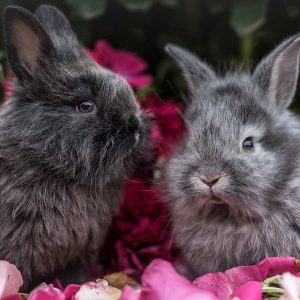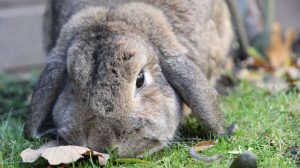Contents
- 1. Rabbits Are Not Hares
- 2. Rabbits Are Not Rodents
- 3. Rabbits Do Not Have Paw Pads
- 4. Rabbit Skin Is Fragile
- 5. Rabbits Have A Long History With People
- 6. Rabbits Eat Their Droppings
- 7. Rabbits Have A Blind Spot
- 8. Rabbit Teeth
- 9. Two Wild Rabbit Species Are Critically Endangered
- 10. Giant Rabbits Are Rather Unique
- 11. Rabbits Tiptoe
- 12. Rabbit Record Holders
- 13. No Hairballs On The Floor
- 14. So Many Rabbit Breeds!

Rabbits are furry, cute, and known for their ears and hopping. But there’s more to rabbits than these obvious facts. How many of these rabbit facts do you know?
1. Rabbits Are Not Hares
Although rabbits and hares are members of the same taxonomic family, Leporidae, they are classified in separate genera. Rabbits are generally smaller than hares, have smaller ears, and can’t run as fast. Their young are born furless with eyes closed, but hares birth young that are furred and have eyes open.
2. Rabbits Are Not Rodents
Rabbits share some traits of rodents, which initially had them classified in the order Rodentia. But important differences between rabbits and rodents were recognized in the early 1900s. In 1912, J.W. Gidley classified rabbits, hares, and pikas in a separate order, Lagomorpha, instead of the order Rodentia. A key difference between the two orders is that lagomorphs have peg teeth, which are a second set of small incisors behind their front incisors.
3. Rabbits Do Not Have Paw Pads
Rabbits are a wee bit like Hobbits in that they have furry feet. In fact, fur is the only thing on their feet. This lack of paw pads makes them more sensitive to the surfaces they walk on. Sore hocks, or pododermatitis, can occur from hard surfaces, including wired cage bottoms. The shorter fur of Rex and Mini Rex rabbits put them even more at risk for this painful condition.
4. Rabbit Skin Is Fragile
Rabbit skin is so delicate that it can actually tear. Trimming fur requires precision, because a trimmer or scissors could rip or tear the skin.
5. Rabbits Have A Long History With People
Ancestors to today’s rabbits appear in the fossil record about 55 million years ago, although some scientists believe rabbits are even older. Modern humans appeared about 200,000 years ago. Rabbits were domesticated during the fifth century by monks in southern France. The first rabbit club for breeding formed in England in 1840.
6. Rabbits Eat Their Droppings
Well, not all their droppings. Rabbits produce two types of droppings: pellets of dry waste and mucus-covered cecotropes that are packed with nutrients. Rabbits eat the cecotropes for the nutrients. This is usually done at night and taken directly from the anus. This habit is called coprophagy.
7. Rabbits Have A Blind Spot

Just beneath the nose of a rabbit is a small area he can’t see; a blind spot. Rabbits are prey animals. Like many other prey animals, their eyes are set farther apart or even on opposite sides of the head. This gives a wider field of view. Rabbits can see almost 360 degrees around them, and while some area is seen by both eyes, most is only seen by one at a time. The trade-off for seeing more is loss of depth perception and the small blind spot in front of their nose.
8. Rabbit Teeth
Rabbits only have enamel on the lip side of their top incisors. Their bottom incisors have enamel on both the lip and tongue sides. And a rabbit’s upper incisors grow a little more slowly than the lower incisors.
9. Two Wild Rabbit Species Are Critically Endangered
The International Union for Conservation of Nature and Natural Resources ranks the risk of extinction for species worldwide. It uses 9 categories: Not Evaluated, Data Deficient, Least Concern, Near Threatened, Vulnerable, Endangered, Critically Endangered, Extinct In The Wild, and Extinct. Currently, the San Jose brush rabbit (Sylvilagus mansuetus) and the Riverine rabbit (Bunolagus monticularis) are critically endangered and only one category away from being extinct in the wild. Several other species are endangered.
10. Giant Rabbits Are Rather Unique
The weight range of wild rabbits varies from a little less than a pound for the pygmy rabbit (Brachylagus idahoensis) to the 6.5 pounds of the Omilteme cottontail (Sylvilagus insonus). The rabbit breeds of the European rabbit (Oryctolagus cuniculus), our pet rabbits, that are recognized by the American Rabbit Breeders Association range from 2.5 pounds to 12 or more pounds for the giant breeds (Checkered Giant, Flemish Giant, French Lop, Giant Angora, Giant Chinchilla).
11. Rabbits Tiptoe
OK, that’s a bit of an exaggeration, but rabbits do walk on their toes. The technical term for this form of movement is digitigrade locomotion. Cats, dogs, and some other mammals also walk on their toes. If you’re wondering, people are plantigrades, meaning we usually walk on the soles of our feet. Horses and cattle are unguligrades and walk on the distal-most tips of their toes.
12. Rabbit Record Holders
Rabbits have earned several Guinness World Records. The oldest rabbit ever lived to be more than 18 years old, the longest rabbit was a Flemish Giant measuring more than 50 inches, longest fur was on an English Angora and measured more than 14 inches, the highest jump was more than 39 inches, the longest jump was more than 9 feet 9 inches, the longest ears were on an English Lop and measured more than 31 inches, and the most slam dunks in a minute by a rabbit clocked in at 7.
13. No Hairballs On The Floor
Rabbits frequently lick their fur to groom themselves, just like cats. Unlike cats, rabbits don’t cough up hairballs. That’s because rabbits can’t vomit. Neither can rodents or horses. Rabbits can suffer slowed gut motility from a buildup of fur, though, which is why it’s important to brush your rabbit daily to minimize the fur he ingests.
14. So Many Rabbit Breeds!
Although our pet rabbits are all the same species, Oryctolagus cuniculus, that single species gave rise to many different breeds. The American Rabbit Breeders Association currently recognizes 49 breeds. The British Rabbit Council recognizes even more. And there are more in other countries.




